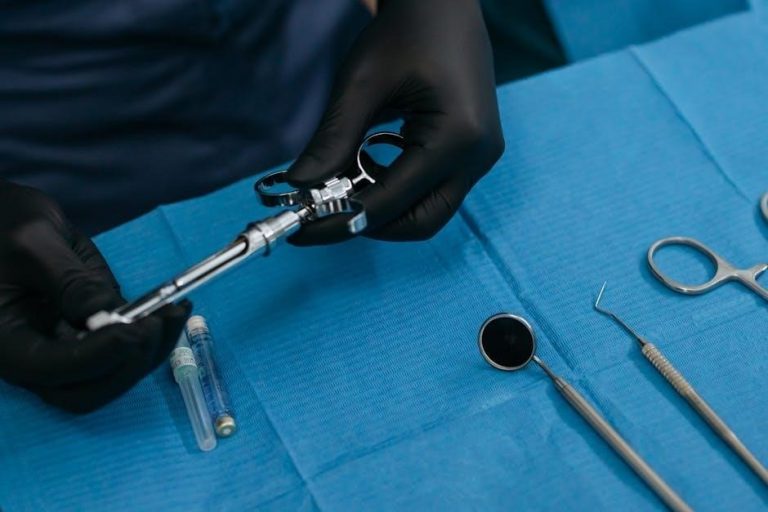Dental instruments are essential tools in modern dentistry, designed for precise procedures. This guide provides a comprehensive overview, including high-quality images and detailed descriptions, helping professionals and students master their use and identification effectively.
Importance of Knowing Dental Instruments
Understanding dental instruments is crucial for effective patient care and procedural efficiency. Accurate identification and use of tools ensure precise diagnoses and treatments, reducing errors. Knowing their names, functions, and characteristics enhances communication among dental teams and improves decision-making. This knowledge also aids in maintaining proper hygiene and sterilization protocols, ensuring patient safety. For students and professionals, mastering dental instruments fosters confidence and professionalism, allowing for better handling of diverse clinical scenarios. Recognizing “false friends” among instruments prevents confusion, while updated resources like PDF guides provide visual and descriptive support for continuous learning and skill refinement in modern dentistry.
Overview of the Guide
This guide provides a detailed exploration of dental instruments, offering insights into their names, functions, and uses. With high-quality images and clear descriptions, it aids in identifying and differentiating tools, even for those with similar appearances. Designed for both students and professionals, the guide covers essential instruments across various dental disciplines, from basic to specialized. It also includes downloadable PDF resources and interactive tools, such as flashcards, to enhance learning. Whether for study or practice, this comprehensive resource ensures a thorough understanding of dental instrumentation, making it an invaluable tool for mastering modern dentistry techniques and improving patient care outcomes effectively.
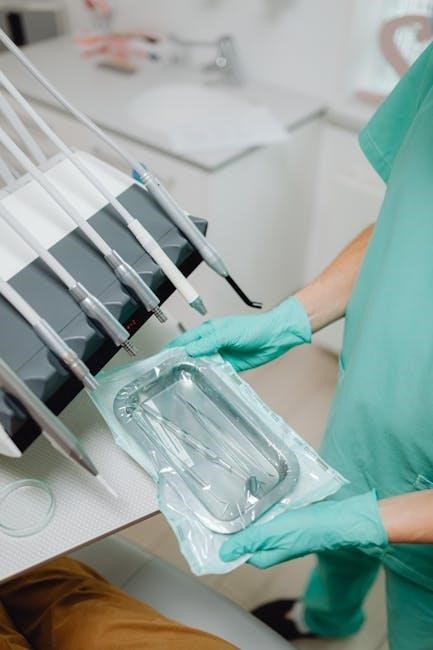
Basic Dental Instruments
Basic dental instruments are essential tools in dentistry, such as dental trays for organizing instruments and mouth mirrors for indirect vision. The guide offers images and names in a PDF, helping professionals and students identify and use these tools effectively in daily procedures.
Common Dental Tools and Their Functions
Common dental tools include mouth mirrors, probes, and scalers, each serving specific purposes. The mouth mirror provides indirect vision, while probes measure pocket depths and detect issues. Scalings tools remove plaque and calculus, essential for hygiene. These instruments, featured in PDF guides, are vital for routine exams and treatments, helping professionals maintain patient care standards effectively. Their functions are clearly outlined with images, making identification and use straightforward for both students and experienced practitioners. Understanding these tools is crucial for delivering precise and efficient dental care.
Essential Instruments for Routine Dental Procedures
Fundamental tools for routine dental care include dental trays, mouth mirrors, probes, and scalers. Dental trays organize instruments per procedure type, while mouth mirrors offer indirect vision. Probes measure pocket depths, aiding in periodontal assessments. Scalings tools remove plaque and calculus, crucial for hygiene. Suction devices maintain a clear field, enhancing visibility. These instruments, detailed in PDF guides with images and names, ensure efficient patient care. Their proper use is vital for both professionals and students, enabling effective diagnosis and treatment in daily practice.

Specialized Dental Instruments
Advanced tools like bone mills and titanium meshes are used in surgical and implant procedures. Orthodontic and periodontal instruments, detailed in PDF guides, enhance precision and effectiveness in complex treatments.
Instruments Used in Surgical Dentistry
Surgical dentistry relies on specialized tools for precise procedures. Bone mills and titanium meshes are used in implant placements, while surgical scalpels and retractors ensure tissue management. Elevators and forceps aid in extractions, and drills prepare bone for implants. These instruments, detailed in PDF guides with images, are essential for complex surgeries, ensuring accuracy and patient safety. Understanding their functions and proper use is critical for successful outcomes in surgical dentistry.
Orthodontic and Periodontal Tools
Orthodontic tools, such as pliers and arch wires, are used to reshape and align teeth. Periodontal instruments like scalers and curettes remove plaque and tartar, treating gum disease. Ultrasonic scalers are also used for deep cleaning. These tools, detailed in PDF guides with images, are essential for specialized dental care. Understanding their functions and proper use is key to effective treatment in both orthodontic and periodontal procedures, ensuring patient comfort and successful outcomes.
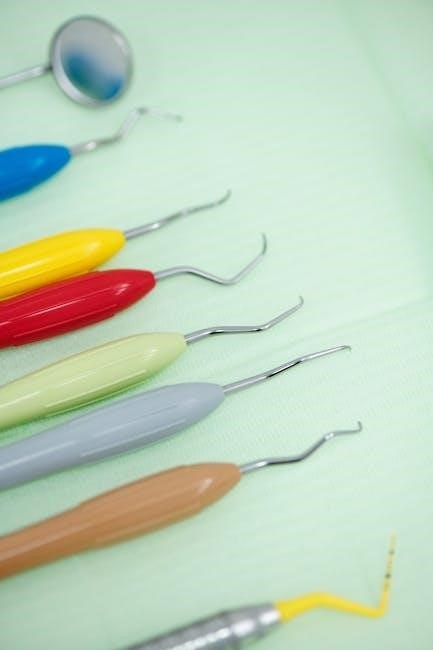
How to Identify Dental Instruments
Recognizing dental instruments requires understanding their shapes, sizes, and functions. High-quality images and detailed descriptions in PDF guides help differentiate tools, ensuring accurate identification for effective use.
Key Characteristics and Features
Dental instruments are designed with specific features to ensure precision and effectiveness. Common tools like dental trays, mouth mirrors, and scalers have unique designs for different procedures. For instance, hygiene trays are used for cleaning, while surgical trays are tailored for complex operations. Instruments often feature curved or angled tips for accessibility and control. High-quality materials, such as stainless steel, ensure durability and sterility. Understanding these characteristics helps in identifying and selecting the right tool for each dental task, making the learning process streamlined and efficient for both students and professionals.
False Friends: Avoiding Confusion Between Similar Instruments
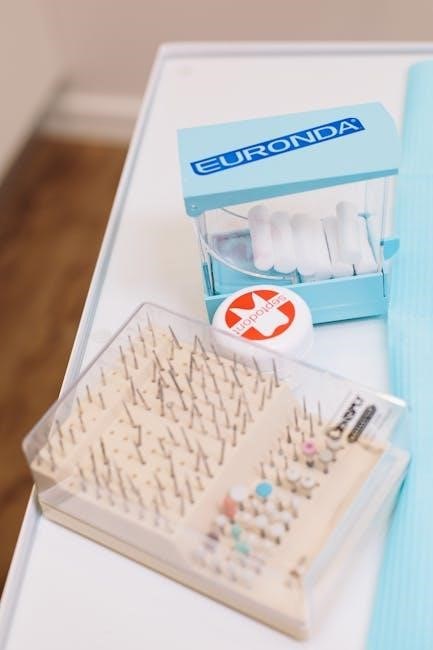
Dental instruments can often appear similar, leading to confusion. For example, scalers and curettes may look alike but serve different purposes. Key features like handle shape, blade type, and tip angle distinguish them. Proper identification ensures accurate use. The PDF guide highlights these differences with detailed images and descriptions, helping users avoid mix-ups. Understanding these nuances is crucial for effective patient care and procedural success. By focusing on distinct characteristics, professionals can master instrument identification and avoid errors in clinical settings.

Dental Instruments in Practice
Dental instruments are crucial in clinical settings, ensuring precise patient care. Proper hygiene and sterilization protocols are essential. Effective use of these tools enhances treatment outcomes and patient comfort.

Hygiene and Sterilization of Dental Tools
Proper hygiene and sterilization of dental tools are critical to prevent infections and ensure patient safety. Instruments must be cleaned and sterilized before each use, with methods like autoclaving being standard. Regular maintenance and storage in sterile environments are essential to maintain their effectiveness and longevity. Adhering to strict hygiene protocols is vital for all dental procedures, ensuring both patient and practitioner safety. This process is non-negotiable in modern dentistry, reflecting a commitment to high-quality care and infection control.
Effective Use of Instruments in Patient Care
Understanding the proper use of dental instruments is crucial for optimal patient care. Each tool is designed for specific tasks, ensuring precise and efficient procedures. By mastering their functions, dentists can enhance diagnosis, treatment, and patient comfort. The guide provides detailed insights into selecting the right instruments for various procedures, from routine exams to complex surgeries. High-quality images and descriptions help practitioners identify and use tools effectively, minimizing errors and improving outcomes. Effective instrument use not only enhances patient safety but also elevates the overall quality of dental care, making procedures more efficient and comfortable for everyone involved.
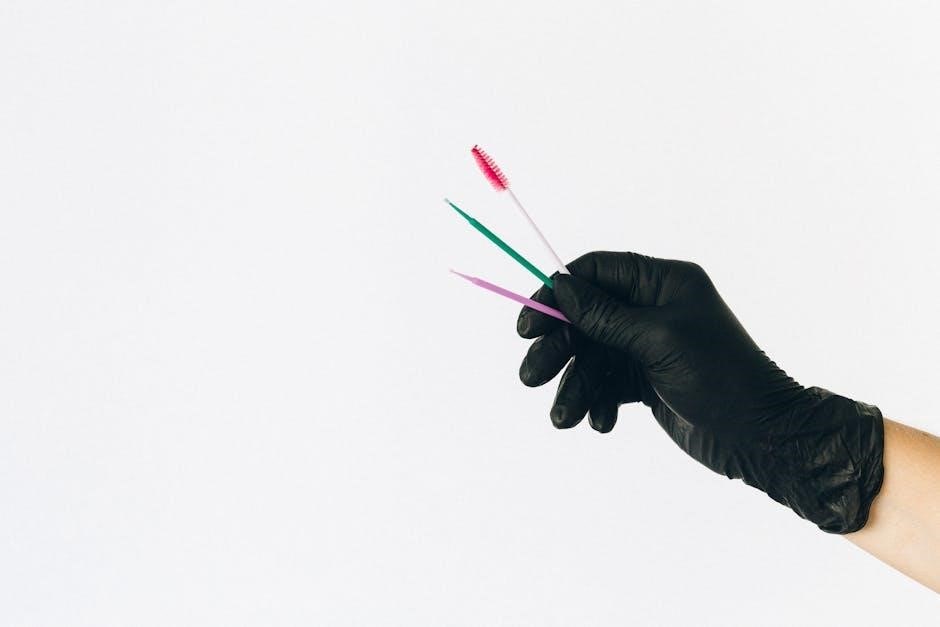
Learning Resources
Downloadable PDF guides and interactive tools provide comprehensive details on dental instruments, including names, pictures, and functions, aiding students and professionals in self-assessment and skill development.
Downloadable PDF Guides for Students and Professionals
These PDF guides provide a detailed overview of dental instruments, including high-quality images, names, and functions. They are organized into clear, two-page spreads, making it easy to identify and differentiate tools. Each entry includes key characteristics, uses, and sterilization tips, ensuring comprehensive understanding. Designed for both students and professionals, these guides are invaluable for learning and reference. They cover basic and specialized instruments, offering a structured approach to mastering dental instrumentation. Downloadable formats make them accessible for self-study and quick consultation, enhancing learning and practical application in dental care settings.
Interactive Tools and Flashcards for Self-Assessment
Interactive tools and flashcards offer an engaging way to learn dental instruments. These resources feature images, names, and functions, allowing users to quiz themselves and assess their knowledge. Flashcards often include high-quality photographs and concise descriptions, making it easy to identify and differentiate instruments. Interactive tools also provide self-assessment features, enabling learners to track progress and focus on areas needing improvement. Designed for both students and professionals, these resources enhance retention and understanding of dental instrumentation through active learning and repetition, making them invaluable for mastering the subject.
Dental instruments are vital for effective patient care, and understanding their names and functions is crucial. This guide provides a clear, visually enhanced resource for mastering dental instrumentation.
Final Thoughts on Mastering Dental Instruments
Mastering dental instruments requires a combination of theoretical knowledge and practical skill. Understanding their names, functions, and proper use is essential for effective patient care. Utilizing resources like PDF guides with images and names enhances learning, especially for distinguishing similar tools. Continuous education and hands-on practice are key to proficiency. Staying updated on advancements ensures clinicians remain competent in modern dentistry. Ultimately, mastery of dental instruments is vital for delivering precise, efficient, and safe treatments, directly impacting patient outcomes and overall satisfaction.
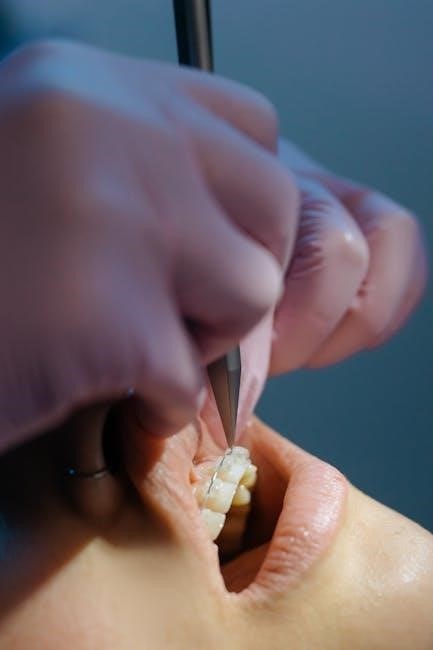
Future Trends in Dental Instrumentation
Future trends in dental instrumentation focus on innovation and technology integration. Advances include AI-driven tools for precise diagnostics and smart instruments with real-time feedback. Digital learning resources, such as interactive PDF guides with 3D images, will enhance education. Eco-friendly materials and ergonomic designs are gaining prominence, prioritizing sustainability and clinician comfort. Customizable instruments tailored to specific procedures are expected to rise, improving efficiency and patient care. These advancements promise to transform dentistry, making practices more effective, sustainable, and patient-centric.
